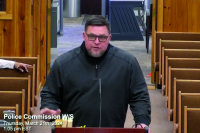An open eye
Let’s imagine for a moment that it is Election Day in some unspecified city, and the proper government officials have gathered in the local polls to record and count the votes. However, when the doors open, no voters appear (it is raining). Noon arrives, the rain stops, but still there are no voters. The officials become uneasy and resort to cajoling a few relatives over the phone to perform their civic duty. Then, one hour before the polls are supposed to close, thousands of voters appear, requiring the officials to extend the voting time.
Finally, the business of counting the votes begins and the officials are amazed to find another disconcerting fact. Only about 25 percent of the voters marked a ballot. 75 percent of the ballots are blank. The marked ballots are distributed through three parties in the political left and right. The majority of the public has abstained!
Like Saramago’s previous novel, Blindness, his new work, Seeing, is a fable laden with allegory. What are we to make of a city in which the citizens refuse to behave in a predictable manner at the polls? The government is forced to hold a second election, but again, the majority of the ballots are blank — and the “blankers” have grown (85 percent). Is this some kind of bloodless revolution? A Gandhi-like response to tyranny?
The befuddled administration decides to implement a series of strategies designed to force the citizens to behave in a predictable manner. However, neither paid informers, spies or lie detectors succeed in uncovering the reason for the “blankers’ rebellion.” Instead, the silent void between the people and their government continues to grow. The elected officials become increasingly anxious and paranoid. When the administration decides to abandon the city — a ploy, which they think, will bring immediate submission — the consequences are surprising. After the “politicos” make a grandiose exit, taking with them the police, the garbage collectors and the mass transit system, the city not only survives but actually appears to be “improved.”
Angered by their increasing impotence, the self-exiled officials resort to violence (a planted bomb); however the people in the abandoned city become united through a series of peaceable demonstrations. The officials accuse the citizens of rebellion and prepare a “siege.” Although newspapers, radio and television stations predict the approach of lawlessness and bloodshed, their dire warnings appear to be groundless. The “ungoverned” city gradually becomes a haven for simple, traditional virtues: home, hearth, family.
At this point, Saramago’s political fable acquires a deeper and more profound significance. Many of the governmental officials and citizens suddenly recall that this is the second time the “inexplicable” has visited their city. Four years ago, nearly the entire populace had been stricken with blindness. (This is the central plot of Saramago’s previous novel, Blindness.) After a nightmarish interim in which the city was reduced to chaos as the helpless citizens fought for food and water, the blindness vanished as quickly as it had appeared. In the years following “the time of blindness,” no one refers to it — acting as though everyone had made an agreement to “forget” the terrible episode. Is there a possible connection between these two events? Could there be a link between “the blankers” and the blind?
Related Items
When a letter arrives in three government offices revealing the fact that one woman had never lost her sight and had saved six citizens by feeding and protecting them, the officials launch an investigation to identify the woman. It quickly becomes evident that the investigation is contrived to create a connection between the woman and “the blankers” despite the fact that no connection exists.
The latter half of Seeing follows the covert activities that are launched by the government and the personal anguish experienced by one remarkable man — the superintendent who is in charge of the investigation. When the superintendent realizes that the accused woman and the six people that she saved will be destroyed by his investigation, he becomes increasingly distraught. When he decides to make an attempt to subvert his own investigation by revealing the plot to a newspaper, the editor asks him why he is committing an act that will cost him his life. The superintendent replies, “When we are born, when we enter this world, it is as if we sign a pact for the rest of our life, but a day may come when we will ask ourselves, Who signed this on my behalf?”
The conclusion of this novel has a shattering impact. It is obvious that Saramago intends to make a devastating indictment of all governments everywhere. The author believes that in varying degrees, all governing bodies seek to control and regulate the lives of others. Eventually, all governments will practice deception and use violence to achieve their wishes. As bleak as this message may be, it also acknowledges the existence of an indomitable spirit in humanity — a spirit that can be subdued, but never completely extinguished.
Finally, I feel prompted to mention that reading the works of Jose Saramago is a challenge. Seeing, like his other works, makes no use of proper nouns. People are identified only by descriptive phrases or by their profession (The man with one eye, the dogs of tears, the fireman, the inspector, etc.) This technique is similar to folk tales in which characters are identified by what they do (The King, the miller, the farmer, etc.) In addition, Saramago rarely uses conventional spacing or punctuation, including periods, paragraphs, quotation marks, etc. As a consequence, Saramago’s tale has a kind of rapid or rushing movement. The story seems to be speeding forward since it is unimpeded by grammatical devices. It takes a bit of “getting used to.” Despite his demands on the reader, Saramago is one of the most acclaimed writers in the world today. (He received the Nobel Prize for Literature in 1998.)
(Gary Carden is a writer, storyteller and lecturer whose book, Mason Jars in the Flood, was named Book of the Year by the Appalachian Writers Association. He can be reached at This email address is being protected from spambots. You need JavaScript enabled to view it..)









